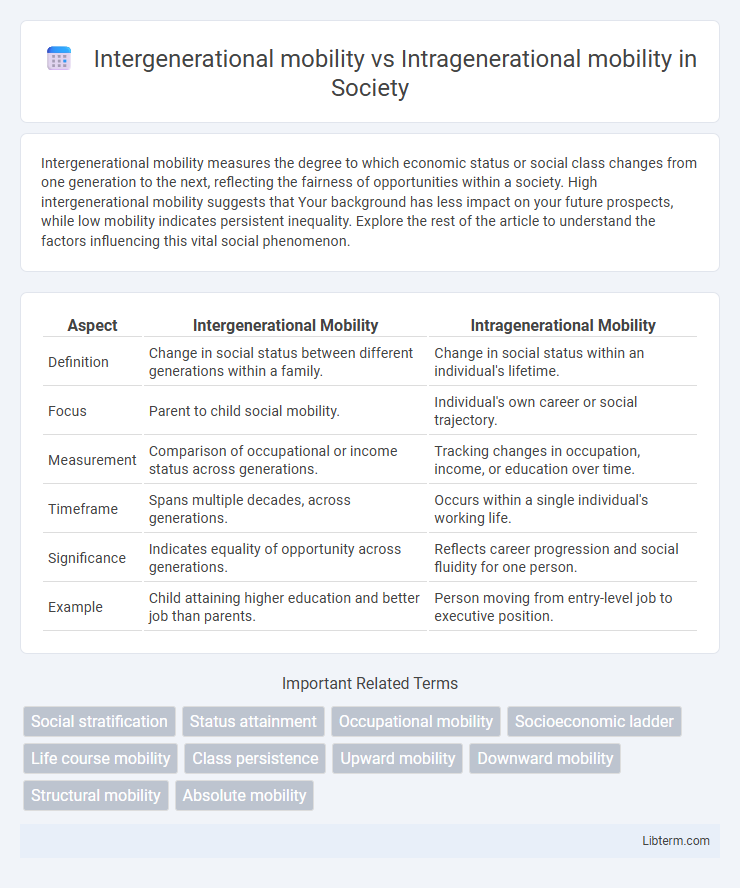Intergenerational mobility measures the degree to which economic status or social class changes from one generation to the next, reflecting the fairness of opportunities within a society. High intergenerational mobility suggests that Your background has less impact on your future prospects, while low mobility indicates persistent inequality. Explore the rest of the article to understand the factors influencing this vital social phenomenon.
Table of Comparison
| Aspect | Intergenerational Mobility | Intragenerational Mobility |
|---|---|---|
| Definition | Change in social status between different generations within a family. | Change in social status within an individual's lifetime. |
| Focus | Parent to child social mobility. | Individual's own career or social trajectory. |
| Measurement | Comparison of occupational or income status across generations. | Tracking changes in occupation, income, or education over time. |
| Timeframe | Spans multiple decades, across generations. | Occurs within a single individual's working life. |
| Significance | Indicates equality of opportunity across generations. | Reflects career progression and social fluidity for one person. |
| Example | Child attaining higher education and better job than parents. | Person moving from entry-level job to executive position. |
Understanding Social Mobility: Key Concepts
Intergenerational mobility measures changes in social status between different generations within a family, highlighting opportunity for economic advancement or decline over time. Intragenerational mobility tracks social movement within an individual's lifetime, reflecting career progress, income changes, or shifts in social class. Understanding both concepts is essential for analyzing social mobility patterns, economic inequality, and the effectiveness of policies aimed at promoting equal opportunity.
Defining Intergenerational Mobility
Intergenerational mobility refers to the changes in social status, economic position, or class that occur between different generations within a family, typically from parents to children. It measures the extent to which individuals can achieve a higher or lower socioeconomic standing compared to their parents, highlighting long-term shifts in opportunity and inequality across generations. This concept differs from intragenerational mobility, which examines social and economic changes experienced by an individual within their own lifetime.
What Is Intragenerational Mobility?
Intragenerational mobility refers to the changes in an individual's social status or economic position within their own lifetime. This type of mobility highlights how a person can move up or down the social or income ladder due to factors such as education, career advancement, or economic shifts. Understanding intragenerational mobility is crucial for analyzing social dynamics and economic opportunities available to individuals over time.
Major Differences Between Intergenerational and Intragenerational Mobility
Intergenerational mobility measures changes in social status or economic position between different generations within a family, typically comparing parents and their children, while intragenerational mobility tracks changes within an individual's lifetime. Key differences include intergenerational mobility reflecting long-term societal shifts and structural changes, whereas intragenerational mobility highlights personal career advancements or decline. Intergenerational mobility tends to focus on inherited advantages and disadvantages, whereas intragenerational mobility emphasizes individual efforts and opportunities in a given economic context.
Factors Influencing Intergenerational Mobility
Intergenerational mobility is influenced by factors such as parental education, wealth distribution, and access to quality education and healthcare, which determine the economic status children inherit from their parents. Social capital, including family networks and community support, also plays a critical role in enabling upward mobility across generations. Economic policies, taxation, and labor market structures shape the opportunities available for individuals to move up or down the socioeconomic ladder compared to their parents.
Determinants of Intragenerational Mobility
Determinants of intragenerational mobility include individual education levels, occupational changes, and wage variations over a person's career span. Economic factors such as market demand, industry shifts, and technological advancements also significantly affect an individual's ability to move within social or economic strata. Personal attributes like skills, job performance, and networking further influence the trajectory of intragenerational mobility.
Societal Impacts of Mobility Patterns
Intergenerational mobility influences the distribution of wealth and opportunities across generations, affecting long-term social equality and shaping societal cohesion. Intragenerational mobility reflects an individual's economic movement within their lifetime, highlighting factors like education, labor market changes, and economic policies that impact social fluidity. Patterns of both mobility types reveal structural barriers or facilitators in society, guiding policymakers toward interventions that promote equitable growth and reduce systemic inequalities.
Measurement and Indicators of Social Mobility
Measurement of intergenerational mobility typically involves comparing parents' socioeconomic status, such as income, education, or occupational class, with that of their adult children to assess changes across generations. Intragenerational mobility is measured by tracking changes in an individual's social or economic position over their working life, often using longitudinal income data or occupational shifts. Key indicators for both types include income percentile ranks, educational attainment levels, occupational prestige scores, and wealth accumulation, which collectively provide insight into the dynamics of social mobility within and between generations.
Case Studies: Global Trends in Social Mobility
Intergenerational mobility examines changes in socioeconomic status between parents and their children, while intragenerational mobility focuses on shifts within an individual's lifetime. Case studies from countries like Sweden and Canada reveal high levels of intergenerational mobility due to strong welfare systems, whereas the United States exhibits lower mobility influenced by educational disparities and income inequality. Global trends highlight that societies with inclusive policies and equitable access to education consistently demonstrate greater opportunities for both inter- and intragenerational social mobility.
Policy Implications for Enhancing Social Mobility
Intergenerational mobility measures the changes in socioeconomic status between parents and their children, while intragenerational mobility refers to changes within an individual's lifetime. Policies aiming to enhance social mobility should address both by improving educational access, workforce training, and social safety nets to reduce structural barriers and promote equal opportunity. Targeted investments in early childhood development and lifelong learning programs can bridge gaps that perpetuate inequality across and within generations.
Intergenerational mobility Infographic

 libterm.com
libterm.com